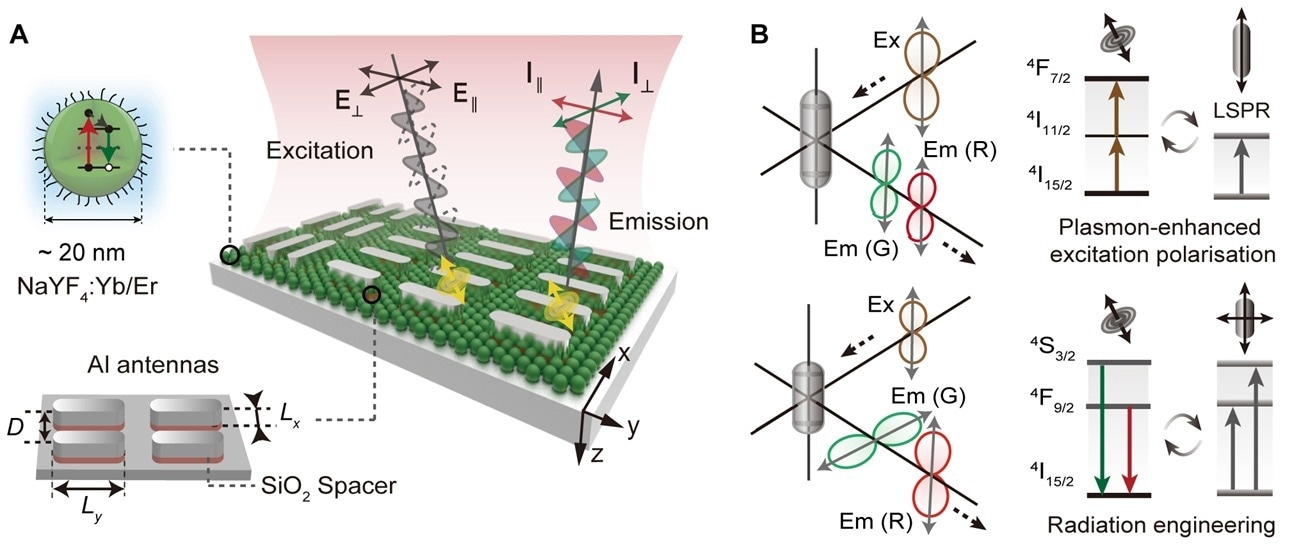To provide exact control over the polarization of isotropic upconversion nanoparticles (UCNPs), researchers at the National University of Singapore (NUS) have developed an upconversion plasmonphore platform. This is accomplished by combining properly crafted anisotropic gap plasmon mode-supported metasurfaces with upconversion activators.
 Figure (A) shows the schematic of the hybrid system comprising metal-insulator-metal nanoantennas and NaYF4:Yb/Er upconversion nanoparticles (UCNPs). Figure (B) presents the simplified energy level diagram depicting how anisotropic gap-plasmon modes interact with the quantum energy levels of UCNPs. The modification of upconversion luminescence polarisation (parallel or anisotropic) depends on the localised surface plasmon resonance (LSPR) wavelength relative to the excitation (Ex) and emission (Em) transitions of UCNPs. Image Credit: XU Jiahui
Figure (A) shows the schematic of the hybrid system comprising metal-insulator-metal nanoantennas and NaYF4:Yb/Er upconversion nanoparticles (UCNPs). Figure (B) presents the simplified energy level diagram depicting how anisotropic gap-plasmon modes interact with the quantum energy levels of UCNPs. The modification of upconversion luminescence polarisation (parallel or anisotropic) depends on the localised surface plasmon resonance (LSPR) wavelength relative to the excitation (Ex) and emission (Em) transitions of UCNPs. Image Credit: XU Jiahui
With potential applications in a variety of domains, such as miniaturized solid-state lasers, ultracompact spectrometers, on-chip molecular sensing, and polarimetric imaging, photon-plasmon coupling in hybrid systems is a valuable tool for examining light-matter interactions at the nanoscale.
The unique emission peaks, substantial anti-Stokes shift, and superior photostability of lanthanide-doped UCNPs make them particularly intriguing as quantum light sources. Information can be identified more precisely because of the distinctive spectroscopic fingerprints these emission peaks generate.
Although surface plasmon-photon coupling in upconversion hybrid systems has been investigated to improve photoluminescence and decay dynamics, polarization anisotropy is challenging to accomplish due to tiny UCNPs’ crystal lattice symmetry. Furthermore, a variety of applications, including biological sensing, display technology, and information encoding, depend on the ability to manipulate light polarization.
Anisotropic gap plasmon mode-supported metasurfaces, or anisotropic gap plasmon activators, are complex nanostructures coupled with upconversion activators to enable precise polarization control over isotropic UCNPs.
The research group led by Professor Xiaogang Liu from the Department of Chemistry at NUS has developed this strategy. The researchers were able to manipulate the light polarization of these isotropic UCNPs in a manner akin to tuning a radio to different radio stations by using metallic rod-like antennas.
By doing so, they were able to overcome the limitations imposed by their crystalline symmetry and regulate the light polarization of these isotropic UCNPs from the visible to near-infrared spectrum. Strong double resonant modes with little interference from one another are guaranteed by the metal-insulator-metal design.
Additionally, it separates the emission and excitation processes of light. With a significant excitation polarization sensitivity of up to 83%, the isotropic UCNPs can be regulated to induce cyclic fluctuations in emission amplitude by utilizing both far-field excitation and near-field electromagnetic interference.
The study team also investigated the effects of the local density of light particles surrounding the antennas on the energy generated by the hybrid nanoplatform. This hybrid nanoplatform can transition between four upconversion polarization states by applying linear stimulation, enabling different degrees of light output in combinations with parallel or orthogonal polarization.
They further clarified how the anisotropic plasmon modes selectively alter the polarization state of the emitted light by their numerical analysis. To be more precise, parallel polarization features result from the excitation polarization determining the upconversion polarization state when the excitation enhancement factors are significantly greater than the emission enhancement factors.
The linked upconversion emitters, on the other hand, created anisotropic light when the emission enhancement factors were similar to the excitation enhancement factors.
The multilevel upconversion polarizations could pave the way for innovative photonic systems, offering the flexibility to tailor light frequencies and directions that use light in unique ways. This opens up exciting prospects for developing compact devices that leverage light in novel ways for advanced photonics.
Xiaogang Liu, Professor, Department of Chemistry, National University of Singapore
Journal Reference:
Xu, J., et. al. (2023) Multi-level upconversion polarization enabled by programmable plasmons. Chem. doi:10.1016/j.chempr.2023.11.007.